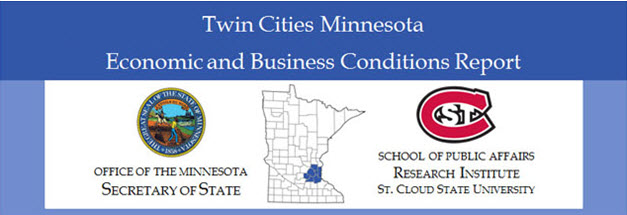Document Type
Research Study
Publication Date
1-2016
Abstract
Twin Cities economic performance is expected to be steady over the next several months according to the prediction of the Twin Cities Index of Leading Economic Indicators (LEI). After increasing by 4.2 points in the second quarter, the Twin Cities LEI fell by 1.61 points in this year’s third quarter as two of the five index components decreased. The LEI is now 4 percent below its level of one year ago. Accounting for the decrease in the index are lower single family residential building permits in the Minneapolis/St. Paul Metropolitan Statistical Area (MSA) and a small decrease in a general measure of statewide business conditions. Three components had a favorable impact on the leading index in the recent quarter. Lower initial claims for unemployment insurance, increased new business filings, and a second measure of general business conditions each made a positive contribution to this quarter’s LEI.
There were 9,684 new business filings with the Office of the Minnesota Secretary of State in the seven-county metro area in the third quarter of 2015—representing a 5 percent increase from one year ago. There were 1,349 new regional business incorporations in the third quarter, a 3.2 percent decrease over year ago levels. Third quarter new LLC filings rose to 6,007 in the seven-county metro area—an 8.9 percent increase compared to last year. New assumed names totaled 1,937 in this year’s third quarter—a reduction of 0.1 percent from the third quarter of 2014. There were 391 new filings for non-profits in the Twin Cities in the third quarter of 2015, 4.5 percent more filings than one year earlier.
Twin Cities employment increased by 0.8 percent over the year ending September 2015. The regional unemployment rate was 3.1 percent in September, an improvement on its 3.4 percent reading one year earlier. September 2015 initial claims for unemployment insurance were lower than year ago levels, falling by 5.1 percent to 6,620. The rate of job vacancies per 100 unemployed in the Twin Cities planning area was 87.43 in the second quarter of 2015. The labor force expanded in the Minneapolis-St. Paul area by 0.5 percent over the past year. Average weekly hours worked were flat in the metro area and the relative cost of living in both Minneapolis and St. Paul appears to have increased. There was a small increase in average hourly earnings in the Twin Cities in the most recent quarter. The value of residential building permits fell by 13.1 percent in the Twin Cities MSA compared to one year ago.
Recommended Citation
MacDonald, Richard A. and Banaian, King, "Twin Cities Area Economic and Business Conditions Report - Third Quarter 2015" (2016). Twin Cities Minnesota Economic and Business Conditions Report. 7.
https://repository.stcloudstate.edu/qebcr_tc_mn/7




